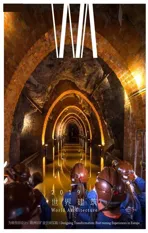高炉可以成为公园的象征吗?北莱茵-威斯特法伦州,德国
2019-10-17彼得拉茨蒂尔曼拉茨TextbyPeterLatzTilmanLatz
彼得·拉茨,蒂尔曼·拉茨 文/Text by Peter Latz, Tilman Latz
尚晋 译/Translated by SHANG Jin

1 杜伊斯堡考珀广场/Duisburg Cowper plaza(图片来源/Sources: Peter Schäfer)
“神话和寓言的世界降临这座老工厂,错综复杂的管道与一组组楼梯、隧道、坡道和人行桥组成的迷宫,巨大地堡构成的要塞,犹如山峦而非建筑;一座由高炉和热风器组成的城市,3 座烟囱高耸入云,成为从远方就能望见的过去的超大符号。”1)
高炉可以成为公园的象征吗?北杜伊斯堡景观公园的地标、抽象的1 号和2 号高炉给出了一种答案。在30 年前项目启动时,最大的挑战在于将业已关闭的高炉厂理解为一种景观。工业模式和经过时间证明的英式景观园林应该成为设计的范本吗?
在分析阶段,我们对铁轨和水系、城市的连接部以及将低矮植物作为信息潜在载体的系统语言提出了问题。我们感到保存它们的可识别性是解析这些空间最有希望的途径。我们也可以将它们在不同高度上的位置解读为“层”。上层是带高位步道的铁轨公园,最下层是水体公园;其间是街道层上的城市步道。各个植物园是不相连的。新增的要素将各个系统从空间上、视觉上或是象征意义上连接成一个新层。我们并没有尝试将公园的5 个层改造成一个美学上的“整体”。它们在各自的范围内仍自成一体;它们可以相互独立存在,无论从上下左右。
这个结果看似杂乱无章。不过,凭借独立的结构化平面,我们证明了这种杂乱并非由混乱随意的法则堆砌出来,而是从有序的规则中形成的。混乱是无法秩序化的,并且只能通过抽象去理解。
通常来说,“遗留物”象征大自然,而“设计物”代表技术或文化。在这座景观公园中,这种常识几乎被颠倒过来。它的布局、建筑、铺地被原状保留;新建物则是自然的象征。在这座公园中,天然与人造景观之间的典型融合将自然的形象拓展到建成物、遗留物、遗迹和荒地的组合,作为城市景观反复出现的要素。
“以这种方式在杜伊斯堡北部营造出一种特殊的景观。对它来说,‘景观’和‘公园’等词都是不适用的,而且在景观建筑史上也没有先例。它是由妙手改造而成的、介于荒野与艺术之间的一片生土。”2)
如今这座公园已有25 年的历史。作为一处文化场所,它吸引着各界艺术的先锋。将废弃钢铁厂的厂区和建筑物改造成景观已不再有试验性。用遗迹和铁锈的深红与草地上萌芽的嫩绿形成反差,对公园文化的要素进行阐释是令人着迷的做法。在国际建筑展(IBA,埃姆舍公园1991-2001)临时展示25 年之后,这座公园已是世界闻名。
“北杜伊斯堡景观公园……是工业荒地复兴的典范、诸多以此为鉴的改造项目的标杆,以及处理工业生产有害残留的榜样。”3)
后续项目之一是都灵的多拉公园。在那里,巨大场馆的支撑结构成了公园的象征性要素。□
"The world of myths and fables took possession of the old iron works with its bewildering bundles of pipes and stairways, underpasses, ramps and walkways, and the gigantic bunkers, more rocky outcrops than built structures; a city of blast furnaces and hot blast stoves with three chimneys towering above - widely visible mega signs of the past."1)
Can a blast furnace be a symbol for a park? The landmark of the landscape park Duisburg-Nord,the abstract blast furnaces 1 and 2, give an answer.At the beginning of the project 30 years ago, the greatest challenge was to understand the closed blast furnace plant as a landscape. Should the patterns of industry or the proven patterns of English landscape gardening be formative for design?
In the analysis phase, we questioned the system languages of railways and water structures,the city connections and patters of flat vegetation as potential carriers of information. We felt that the preservation of their legibility was the most promising approach to decipher the spaces. We can read their location on physically separated heights also as layers. The upper layer is the railway park with its high promenades, the lowest is the water park; in between the city promenades at the street level. The individual fields of vegetation are unconnected. Connecting elements link the individual systems as a new layer physically, visually or symbolically. There is no attempt to transform the five layers of the park into one esthetic "whole".They remain as what they used to be in their extension; they can exist independently next to and on top of each other.
The result seems chaotic. With separate structural plans, we demonstrated however, that this chaos does not arise from the superposition of chaotic and arbitrary principles, but from regular ones. Chaos cannot be ordered and is only understood in abstraction.
Normally, the "left" symbolises nature, the"planned" technology or culture. In the landscape park this general wisdom has almost changed into the opposite. Patterns, buildings, pavements are left and untouched; the newly built is a symbol of nature. In the park, the archetypal dialogue between the wild and the tamed expands the image of nature into a structure of the built, the left, the ruinous and the wild as recurring elements of an urban landscape.
"North of Duisburg a landscape emerged which does not fit the terms 'landscape' and 'park'and which has no real precedent in the history of landscape architecture. It is a piece of land between wilderness and art, which is given over to careful transformation."2)
The park became 25 years old. As a place of culture, it attracts the avant-garde of the arts.Transforming areas and structures of abandoned ironworks into landscape is no longer an experiment. The interpenetration of elements of garden culture with the ruinous and the rust red in contrast to the fresh green budding of pastures can be addictive. A quarter of a century after the interim presentation of the IBA (International Building Exhibition Emscher Park 1991-2001), the park is world-famous.
"The landscape park Duisburg Nord... a modelevident in the conversion of many industrial sites that followed in its wake - for resurrecting a productive site, and as a prototype approach for mitigating the poisonous relics of manufacture."3)
An example of follow-up projects is the Parco Dora in Turin, where the supporting structure of huge halls became symbolic elements of the park. □

2 杜伊斯堡水体公园清澈的水道/Clear water canal of Duisburg Water park
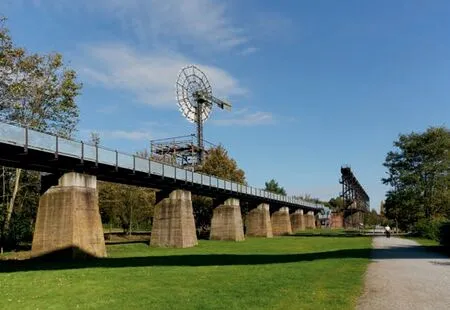
3 火车码头遗址的高位步道/High promenade on the remains of the pier train
注释/Notes
1) Peter Latz in RUST RED - Landscape Park Duisburg North, p12
2) Karl Ganser in RUST RED - Landscape Park Duisburg North, p8
3) Marc Treib in RUST RED - Landscape Park Duisburg North, p9
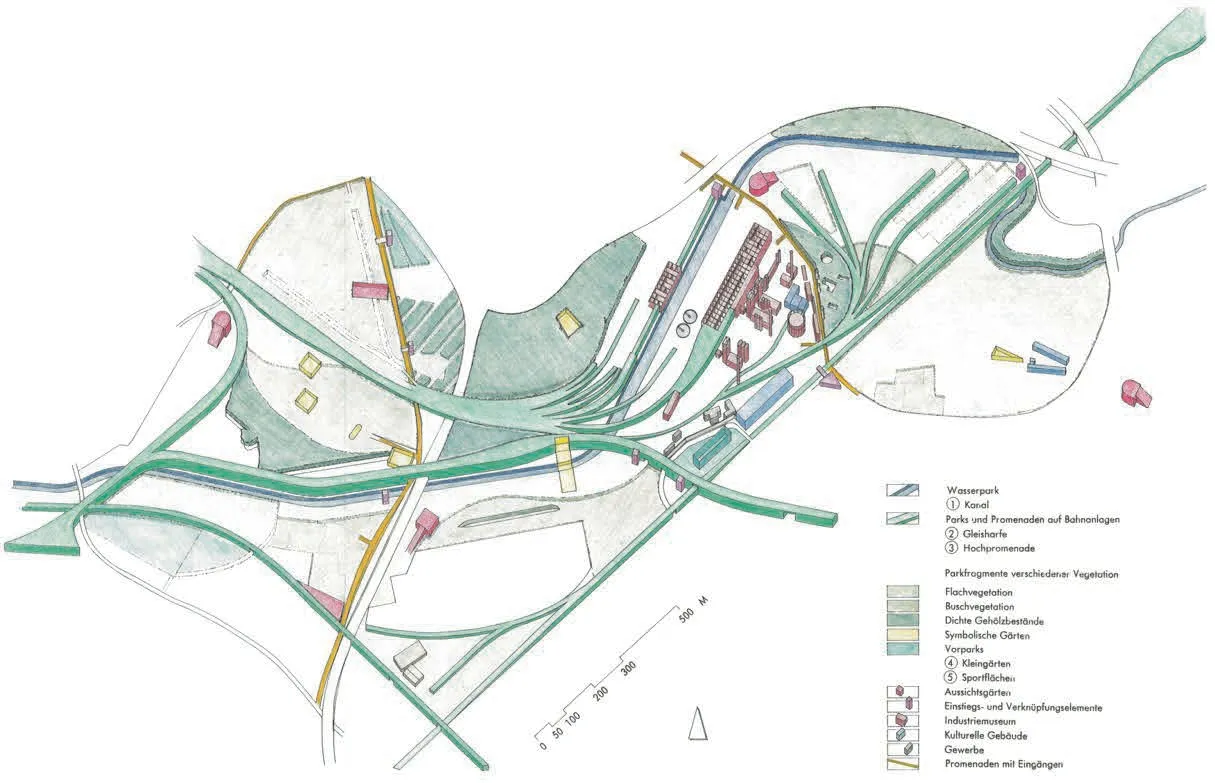
4 竞赛设计平面:为了保持每层独立而不改变其构型,该体系是分层绘制的。为了说明概念,它们被抽象并叠加在一起:绿色代表铁轨公园,蓝色是水体公园,而黄色是城市步道/Competition plan: In order to keep autonomous single layers and not to adjust their configuration, the systems were illustrated separately. To clarify the concept they were abstracted and overlaid: the Railway Park is green, the Water Park is blue and the City Promenades are yellow(图片来源/Sources: ROSTROT)
项目信息/Credits and Data
项目/Project: 北杜伊斯堡景观公园/Landschaftspark Duisburg Nord
地点/Location: 德国杜伊斯堡/Duisburg, Germany
主持建筑师/Principal Architect: Peter Latz (Latz + Partner,Kranzberg)
建筑设计/Architecture: Günther Lipkowsky, Oberhausen
施工/Realisation: Prof. Wigbert Riehl, Latz Riehl Schulz, Kassel规划/Planning: Christine Rupp-Stoppel, Karl-Heinz Danielzik (Latz + Partner, Kranzberg)
基底面积/Built Area: 180hm2
造价/Cost: 1500万欧元,不包括建筑物、污水渠翻修和
管道工程的费用/15M EUR, excluding costs of buildings,renovation and piping of the sewage canal
设计与施工时间/Period of Design and Realisation: 1990-2002
项目/Project: 都灵多拉公园/Parco Dora Turin
地点/Location: 意大利都灵/Turin, Italy
主持建筑师/Principal Architect: Tilman Latz (Latz +Partner, Kranzberg)
项目协调/Project Coordination: STS S.p.A., Bologna
建筑设计与静力结构/Architecture and Statics: Studio Pession Assoc, Turin; CMC Studio Ingegneri Assoc, Turin
照明设计/Lighting: Pfarré Lighting Design München
艺术设计/Art: Ugo Marano, Cetara
规划/Planning: Daniela Strasinsky, Dörte Dannemann (Latz+ Partner, Kranzberg)
基底面积/Built Area: 37hm2
造价/Cost: 2900万欧元/29M EUR
设计与施工时间/Period of Design and Realisation: 2004-2012
评论
张鹏举:北杜伊斯堡景观公园是城市运营视野下生态理想与工业文明平衡发展的设计典范,其教科书式的工业遗产发展模式正在不断地被世人模仿与复制,但始终难以被模仿和超越的,却是设计者那自由、自信的设计手法:多维的景观系统虽是对碎片化景观要素一定程度上的整理,但更多的形式语言,是对不同类型问题自然应对的结果。独立的景观系统间难以找到刻意强调整体的设计痕迹,这种“无序”的系统在邂逅的那一瞬间,却产生了惊艳的视觉和行为体验。这种结构化的平面构成似乎代表了另一种建构的可能性,以此重新定义公园景观的设计。
张杰:数字时代的产品因其抽象的形式传达着一种未来主义的神秘,与之相反,传统的工业技术却常常通过外表,直观地表达其内在的逻辑,如同透明的机械钟一样,它的神秘在于其虽可见但又深不可测的复杂性。杜伊斯堡利用老工业区改造而成的后工业景观公园就是这样一个例子。公园的设计充分利用了老旧工业设备极具冲击力的复杂造型和整体环境,让人身处于一个富于叙述性的时空之中,而新的景观元素又拉大了人们与过去时空的距离,使老故事中的场景与人物似乎更加真实。
Comments
ZHANG Pengju: Landschaftspark Duisburg-Nord,in the view of city operation, functions as a good design model of the balanced development between ideal ecology and industrial civilisation. Its textbookstyle model of industrial heritage development has been constantly imitated and duplicated. Yet, what is difficult to be imitated and surpassed, though, is the free and confident design method that the designer possessed: the multi-dimensional landscape system,to a certain degree, is about the reorganisation of fragmented landscape elements. However, for more of the form of language, it is about the natural responses to different types of problems. It would not be easy to find the emphasised overall trace of the design in the independent landscape system. Such "disordered"systems, though, create breathtaking visual and behavioral experiences when they encounter each other. This structured plane composition seems to represent another possibility of construction, which redefines the park landscape design. (Translated by Dandan Wang)
ZHANG Jie: Products in the digital age convey a futuristic mysterious message due to their abstract forms. On the contrary, traditional industrial technologies often directly express their internal logic through their appearance, just like transparent mechanical clocks, whose mystery lies in their visible but unfathomable complexity. Duisburg's post-industrial landscape park is such an example. The design of the park makes full use of the complex shapes and overall environment of the old industrial equipment with great impact, allowing people to experience a narrative time and space, while the new landscape elements extend the distance between people and the past time and space,making the scenes and characters in the old stories more real. (Translated by PANG Lingbo)
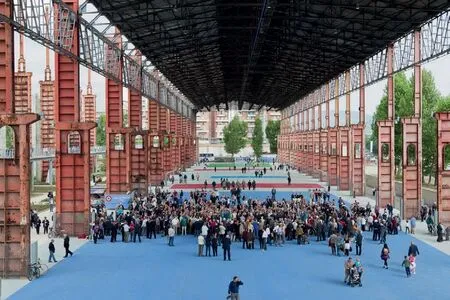
5 都灵多拉公园/parco Dora Turin, Lotto Vitali(图片来源/Sources: Mattia boero)
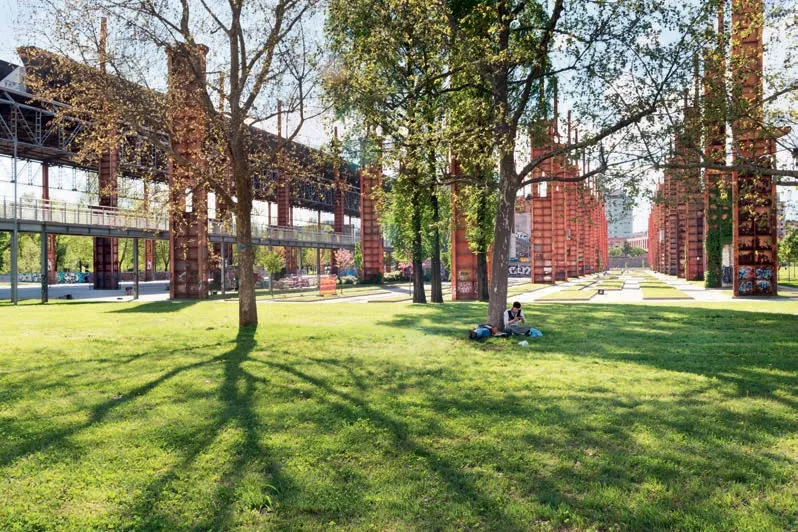
6 都灵多拉公园/parco Dora Turin, Lotto Vitali(图片来源/Sources: Ornella Orlandini)
